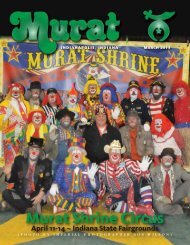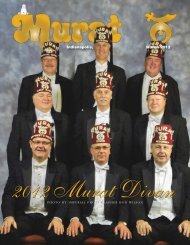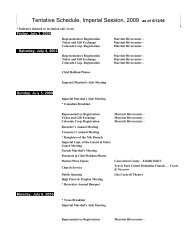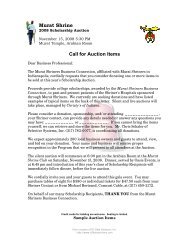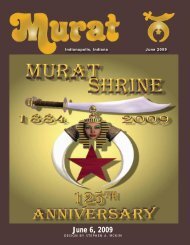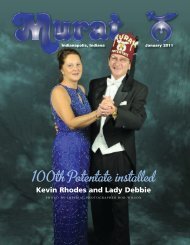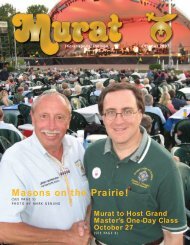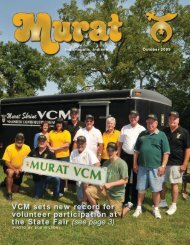Come ride with US
5.07 Murat - Murat Shrine
5.07 Murat - Murat Shrine
- No tags were found...
You also want an ePaper? Increase the reach of your titles
YUMPU automatically turns print PDFs into web optimized ePapers that Google loves.
Highlanders<br />
Hello Nobles!<br />
On March 24, the Highlanders traveled<br />
to Orak Temple in Michigan City to<br />
participate in their 30th annual Tartan Ball.<br />
Also performing were the Pipes and<br />
Drums of Orak, the Michigan City Sheriff’s<br />
Pipe Band, the Northwest Indiana Pipe<br />
Band, and some wonderful Highland<br />
dancers.<br />
In commemoration of the 30th<br />
anniversary, the Highlanders presented a<br />
beautiful Masonic sword to the band. (See<br />
photo) It was a great evening of piping,<br />
food, fun and fellowship.<br />
Bagpipe Basics – How Does It<br />
Work?<br />
This is the first in a series of articles<br />
to reveal some of the mysteries of pipes<br />
and drums. We’ll start out <strong>with</strong> the basics<br />
of the bagpipe.<br />
The bagpipe we play is called “The<br />
Great Highland Bagpipe.” There are<br />
many other types and variations of bagpipes<br />
throughout the world, but the GHB<br />
is the most recognized.<br />
A bagpipe consists of a bag, blowpipe,<br />
drones and chanter. The bag is an<br />
air reservoir and is made of hide or synthetic<br />
material. It does not contain bellows<br />
or any other air pumping device. Air<br />
is blown through the blowpipe into the<br />
bag, and the air pressure <strong>with</strong>in the bag is<br />
maintained by squeezing it <strong>with</strong> the left<br />
arm. A check valve <strong>with</strong>in the blowpipe<br />
prevents air from escaping back through<br />
the blowpipe. There are three drones tied<br />
into the bag – two tenor drones and one<br />
bass drone. These produce the ‘hum’<br />
behind the melody. The melody is produced<br />
by the chanter, the little pipe in<br />
front. The chanter is simply a cylindrical<br />
tube <strong>with</strong> holes drilled into it. Fingers are<br />
placed over the holes in various configurations<br />
to produce musical notes. There<br />
are only nine notes in the musical scale of<br />
a bagpipe. Tens of thousands of tunes<br />
have been composed on variations of<br />
these nine notes!<br />
Bagpipes are traditionally made of a<br />
hard, heavy wood called African<br />
Blackwood. There are several other hardwoods<br />
also used, as well as a hard plastic<br />
called polypenco. Wooden parts are<br />
hand crafted on lathes, although some<br />
manufactures now use CAD techniques.<br />
Bagpipes are a reed instrument, but<br />
unlike any other reeded instrument, there<br />
are four separate reeds contained in the<br />
set. The chanter has a reed similar to the<br />
‘double reed’ of an oboe. The chanter<br />
reed is made of cane. Each drone also<br />
has a reed. The two tenor drones are set<br />
at the same pitch, tuned one octave lower<br />
than the ‘low A’ on the chanter. The bass<br />
drone (the longer one next to the piper’s<br />
head) is set one octave lower than the<br />
Joe “Wee Piper” Ketterman<br />
Andrew Nowaczyk (President Orak Pipes and Drums) looks on as Tom Houts<br />
(P/M Orak and M.C. Sheriff’s bands) proudly displays the sword presented by the<br />
Murat Highlanders in recognition of their 30th Anniversary Tartan Ball. (Photo by<br />
Lee Langlotz)<br />
tenors. These reeds were traditionally<br />
made of cane, but now most pipers use a<br />
synthetic reed of plastic, glass fiber, or<br />
even carbon fiber.<br />
Well, that is a basic description of<br />
the bagpipe. Later articles will discuss<br />
such issues as tuning (yes you can tune<br />
bagpipes) and learning to play. Stay<br />
tuned for more.<br />
BECOMING A HIGHLANDER<br />
The band is always looking for new<br />
members. Musical experience is helpful.<br />
We supply instruction for piping and<br />
drumming. If you are interested, please<br />
visit one of our meetings or practices.<br />
Our business meetings are the first<br />
Monday of each month at 7 p.m. in the<br />
Nile Room, which is in the lower level of<br />
the Shrine Club. Practices are the second<br />
and fourth Mondays at the Gatling Gun<br />
Club. Rookie practice and instruction<br />
begins at 6:30 p.m. and the entire band<br />
rehearsal begins at 7 p.m. For additional<br />
information, contact Joe “Wee Piper”<br />
Ketterman at (317) 849-1807 or jmketterman@aol.com.<br />
MAY 2007 27



